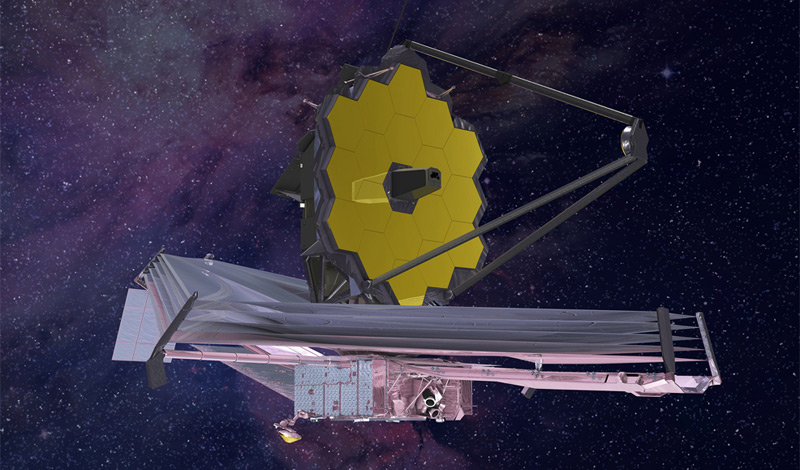
12th July 2022
First images from the James Webb Space Telescope
Following several months of testing and configuration, the first suite of images has been released from the James Webb Space Telescope (JWST), successor to the Hubble Space Telescope.

Credit: Northrop Grumman
The dawn of a new era in astronomy is here as the world gets its first look at the full capabilities of the James Webb Space Telescope (JWST), developed by NASA in partnership with ESA (European Space Agency) and the CSA (Canadian Space Agency).
While the aging Hubble Space Telescope requires weeks to produce images, the JWST is fast enough to generate them in a matter of hours. Its ultra-high resolution and spectroscopic data signify a truly next-generation observatory. Astronomers expect it to reveal a treasure trove of cosmic features that until now have remained elusive.
“Today, we present humanity with a groundbreaking new view of the cosmos from the James Webb Space Telescope – a view the world has never seen before,” said NASA Administrator Bill Nelson. “These images, including the deepest infrared view of our universe that has ever been taken, show us how Webb will help to uncover the answers to questions we don’t even yet know to ask; questions that will help us better understand our universe and humanity’s place within it.
“The Webb team’s incredible success is a reflection of what NASA does best. We take dreams and turn them into reality for the benefit of humanity. I can’t wait to see the discoveries that we uncover – the team is just getting started!”
Webb’s first observations were selected by a group of representatives from NASA, ESA, CSA, and the Space Telescope Science Institute. They reveal the capabilities of all four of Webb’s state-of-the-art scientific instruments:
SMACS 0723
Webb has delivered the deepest and sharpest infrared image of the distant universe so far – and in only 12.5 hours. For a person standing on Earth looking up, the field of view for this new image, a colour composite of multiple exposures each about two hours long, is approximately the size of a grain of sand held at arm’s length. This deep field uses a lensing galaxy cluster to find some of the most distant galaxies ever detected. This image only scratches the surface of Webb’s capabilities in studying deep fields and tracing galaxies back to the beginning of cosmic time.
Click to enlarge
WASP-96b (spectrum)
Webb’s detailed observation of this hot, puffy planet outside our Solar System reveals the clear signature of water, along with evidence of haze and clouds that previous studies of this planet did not detect. With Webb’s first detection of water in the atmosphere of an exoplanet, it will now set out to study hundreds of other systems to understand what other planetary atmospheres are made of.

Southern Ring Nebula
This planetary nebula, an expanding cloud of gas that surrounds a dying star, is approximately 2,000 light years away. Here, Webb’s powerful infrared eyes bring a second dying star into full view for the first time. From birth to death as a planetary nebula, Webb can explore the expelling shells of dust and gas of aging stars that may one day become a new star or planet.
Click to enlarge
Stephan’s Quintet
Webb’s view of this compact group of galaxies, located in the constellation Pegasus, pierced through the shroud of dust surrounding the centre of one galaxy to reveal the velocity and composition of the gas near its supermassive black hole. Now, scientists can get a rare look, in unprecedented detail, at how interacting galaxies are triggering star formation in each other and how the gas in these galaxies is being disturbed.
Click to enlarge
Carina Nebula
Webb’s look at the ‘Cosmic Cliffs’ in the Carina Nebula unveils the earliest, rapid phases of star formation that were previously hidden. Looking at this star-forming region in the southern constellation Carina, as well as others like it, Webb can see newly forming stars and study the gas and dust that made them.
Click to enlarge
—
• Follow us on Twitter
• Follow us on Facebook
• Subscribe to us on YouTube
Comments »



